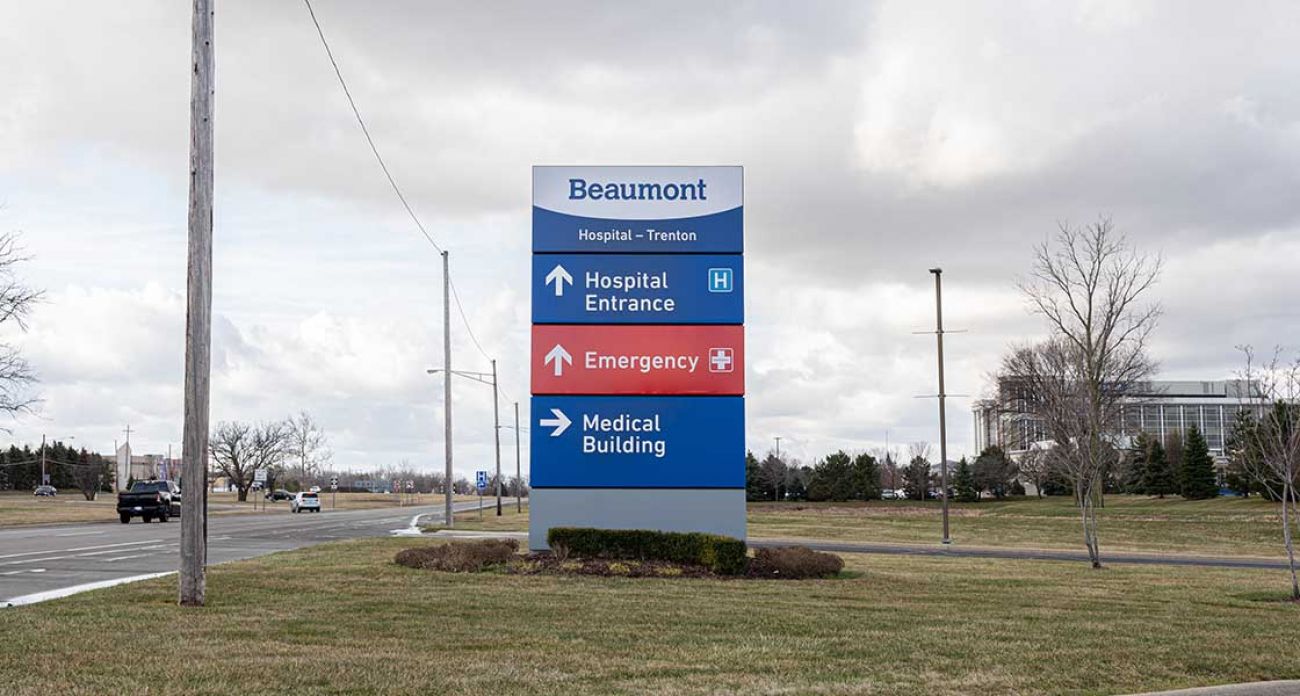Why Michigan hospitals are laying off workers as they battle coronavirus

The coronavirus pandemic has tanked large sectors of Michigan’s economy, leaving more than a million people jobless, including workers in restaurants, entertainment, travel and government.
Across parts of the country, health care systems have seen their staff, equipment and physical space stretched beyond capacity to care for an influx of COVID-19 patients. Some have called on retired doctors and reassigned doctors and nurses from other specialties to help with the surge.
But the pandemic has been no windfall for the health care industry. It may be filling up hospital wards, but COVID-19 is crushing hospital budgets. As a result, hospital systems in Michigan and other states are struggling, slashing staff, and instituting furloughs and pay cuts as the crisis prolongs.
Long a job-creating stalwart in the U.S. economy, the health care sector shed more than 43,000 jobs in March, mostly due to the shuttering of primary care and dental offices in an effort to stem the spread of the coronavirus. The hemorrhaging has continued in April, as revenue losses drive further belt-tightening at hospitals across the country.
Beaumont Health, the state’s largest health system, is the most recent to announce steep financial losses and layoffs for nearly 3,000 employees, with 450 jobs permanently eliminated, the result of the systems’ focus on thousands of COVID-19 patients. The Southfield-based health system has discharged 2,076 patients, with 154 patients taken off ventilators, since mid-March, and has more than 700 COVID-19 patients still hospitalized.
Many other Michigan hospitals and health systems announced similar, though less steep, cuts in recent weeks, even as the state’s number of COVID-19 patients continued to climb.
To prepare for the anticipated wave of COVID-19 patients, Gov. Gretchen Whitmer on March 20 joined many other governors in issuing executive orders requiring the postponement of elective, non-essential procedures such as knee and hip replacements and the closure of many medical and dental offices in an effort to conserve personal protective equipment, staff and space.
Stories from the front
Bridge Magazine, Detroit Free Press and Michigan Radio are teaming up to report on Michigan hospitals during the coronavirus pandemic. We will be sharing accounts of the challenges doctors, nurses and other hospital personnel face as they work to treat patients and save lives. If you work in a Michigan hospital, we would love to hear from you. You can contact reporters
The strain has highlighted a sad irony of the U.S. health care system: Without more lucrative income from elective procedures, outpatient primary care and specialty doctor visits, hospitals are in danger of not being able to pay their employees, even as their medical staff are needed most.
Here’s what you need to know about hospital finances and layoffs in the wake of the COVID-19 pandemic.
Revenue loss, increased costs spell disaster
Hospitals make money from primary care and specialty office visits, and from elective procedures performed outside the hospital — think outpatient surgeries and diagnostic, imaging and screening services such as mammography, biopsies and MRIs.
For most hospital systems, these visits and procedures are the “bread and butter” of the operation, making up more than half — and in some cases up to three-quarters — of revenue.
For decades, the proportion of health system revenue coming from hospitalized patients has been dropping, while the share coming from outpatient visits and services has risen. Aggregate hospital revenue from outpatient services grew from 30 percent in 1995 to 47 percent in 2016, according to research by the Deloitte Center for Health Solutions.
COVID-19 slammed the brakes, hard, on this source of revenue by shutting down outpatient offices and cancelling the scheduling of many imaging tests and elective procedures.
Beaumont Health CEO John Fox, who announced Tuesday he would take a 70 percent temporary pay cut, said in March the health system expected a 20 percent to 40 percent drop in revenue as a result of a “shift from high revenue surgical and related procedures to much lower revenue medical inpatients.” (It’s worth noting that most layoffs involve administrative jobs, not front-line medical workers.)
Henry Ford Health System, which has not announced pay cuts or layoffs in response to the pandemic, said postponement and cancellation of elective procedures, surgeries and appointments has resulted in a nearly 50-percent reduction in revenue for the most recent week in April, compared to last year.
While both health systems have plenty of hospitalized COVID patients to care for, these patients don’t make them nearly as much money. Overall, COVID care likely costs hospitals money, instead, because they are paying out more in bonuses and overtime to their overworked staff, paying inflated prices for harder-to-find personal protective equipment needed to care for these patients, and have diverted hospital beds from other, more lucrative areas of the hospital, said Marianne Udow-Phillips, founding executive director of the Center for Health research Transformation (CHRT) at the University of Michigan.
Pre-pandemic occupancy rates at Michigan Medicine, for example, were about 96 percent, Udow-Phillips said. Since the virus hit Michigan, many of those beds have sat empty to reserve resources for coronavirus cases. “We have a lot of [COVID-19] patients,” Udow-Phillips said, “but it’s a relatively small percentage of our total capacity.”
The loss of revenue is compounded, in part, by the demographics of the pandemic and existing shortfalls in reimbursement by Medicare and Medicaid. Most patients who need intensive care and have longer hospital stays are older, and covered at least in part by Medicare. The federal health insurance for people older than 65 reimburses hospitals about 87 cents for every dollar spent to care for Medicare patients, according to 2018 data from the American Hospital Association.
Rural hospitals already on the brink, suffer more
If the pandemic is stressing and straining urban health care systems, it’s poised to deal a death blow to some rural hospitals, which were already struggling to stay open in many parts of the country, as Bridge Magazine has reported extensively.
Of roughly 2,000 rural U.S. hospitals, roughly half were operating at a financial loss in February, said Alan Morgan, CEO of the National Rural Health Association. The group reports 126 rural hospitals have closed across the country since 2010, and two more have closed since April. More than a dozen in Michigan told Bridge last year they were in danger of shutting.
Rural hospitals are even more sensitive to the loss of outpatient revenue, Morgan said, because that’s what they do most: “Rural hospitals do primary care and general surgery,” he said, and their patients are on average older, poorer, sicker and less-insured than those in urban areas. “Outpatient elective procedures represent 70 to 80 percent of their revenue.”
“Obviously it was an issue where they were literally just struggling to do payroll,” before, and now have had to lay off doctors and nurses, or cut their pay.
“This is crazy, because the one thing that unifies rural America is [concern over] a shortage of health care professionals,” he said.
About three-quarters of rural counties across the United States have at least one confirmed case of COVID-19, Morgan said, but most have very few overall.
Despite the small numbers, it still made sense, from a public health standpoint, for rural hospitals to cancel procedures and increase their capacity to care for COVID patients, he said. That’s because when the disease hits a small community, the hospitals are even more quickly overwhelmed than in urban areas.
“They can go from having one bed filled in the morning to being maxed out with 10 to 15 patients just hours later,” he said, as has been the case in rural areas of Louisiana, Indiana, Colorado and Utah.
Help can’t arrive soon enough
The U.S. health care system was thrown a lifeline in late March with the passage of the Coronavirus Aid, Relief, and Economic Security (CARES) Act, which provides $100 billion in relief funds to hospitals and healthcare providers to support care of COVID-19 patients, and, importantly, cover lost revenue.
Congress and the White House have since agreed on a spending package that will add $75 billion to the CARES Act relief fund.
An initial $30 billion in grants, which do not have to be repaid, was due to reach providers starting April 10. About $936 million was allocated to Medicare-enrolled Michigan hospitals and healthcare providers.
The grants, in addition to a three-month advance on Medicare payments to hospital systems during the crisis, have helped most hospital systems cover the immediate costs of making payroll in March.
But so far, they’ve not been enough to prevent the industry from widespread layoffs and other cost-cutting measures.
Even the full $175 billion, when it is paid, likely won’t be enough to prevent collapse for some health systems if the pandemic lasts, or returns, said J.B. Silvers, a professor of health finance at Case Western Reserve University. Silvers is calling for a national health system bailout on the order of the one given to keep U.S. banks afloat in 2008, which was at least $700 billion.
CARES Act funding should give most rural hospitals a month’s cushion, Morgan said, and Congress is expected to pass further relief funding targeted to rural hospitals that may add some more breathing room.
“That should get them to June or July,” he said. The biggest unknown, he said, is what happens after that: Will hospitals be able to bring back the outpatient and elective care they’ve lost and, crucially for the rural healthcare system, will laid-off doctors and nurses, as well as those who have gone to COVID-hotspots to help out, return to rural communities to work again?
In a plan to guide the reopening of the health care system post-pandemic developed by the American College of Surgeons (ACS), American Society of Anesthesiologists (ASA), Association of periOperative Registered Nurses (AORN) and American Hospital Association (AHA), elective surgeries and other procedures could begin once cases of COVID-19 have dropped for a consecutive two-week period. Michigan has not seen such a consistent decline in cases.
In the past week, a few southeast Michigan hospitals have begun to expand the surgeries and procedures they will perform. The hope is that sometime over the summer, hospitals will start to see revenue recover as more patients return.
A ‘new normal’
There may be no return to normal for the U.S. health care system, though.
“If we knew that everyone who postponed a mammogram or colonoscopy would go get it post-pandemic, then total spending would go up,” said Dr. A. Mark Fendrick, a primary care physician and director of the Value-Based Insurance Design center at the University of Michigan. “Whether or not these patients will return is a big unknown.”
Fendrick and others believe that not everyone will return to get the care they need. On the flip side, he said, we’ll avoid some of the unnecessary procedures that we saw before the pandemic, too.
People are unlikely to be comfortable going to hospitals and doctor’s offices for a while after the pandemic eases, said Udow-Phillips. And the pent-up demand for services could take two years, or more, to resolve, she said.
Many health care experts say that some of the innovations that have helped get us through the pandemic, including telemedicine and virtual visits, and the ability of nurses and doctors to practice outside of their specialty areas and across state lines, may be here to stay.
And hospital consolidation and mergers, which were already happening at a breakneck pace, will likely accelerate as health systems look to further insulate their finances, Udow-Phillips said.
“Health care systems are going to need more support, because the system is going to have to retool and regear,” she said.
That transition is going to take time. Years, even.
“Provider and hospital finances are going to be a challenge for the long term, and they’re going to need continued support and subsidization.”
RESOURCES:
- Hey, Michigan, here’s how to make a face mask to fight coronavirus
- Michigan coronavirus dashboard: cases, deaths and maps
- Michigan families can get food, cash, internet during coronavirus crisis
- How to give blood in Michigan during the coronavirus crisis
- 10 ways you can help Michigan hospital workers right now
- Michigan coronavirus Q&A: Reader questions answered
- How to apply for Michigan unemployment benefits amid coronavirus crisis
See what new members are saying about why they donated to Bridge Michigan:
- “In order for this information to be accurate and unbiased it must be underwritten by its readers, not by special interests.” - Larry S.
- “Not many other media sources report on the topics Bridge does.” - Susan B.
- “Your journalism is outstanding and rare these days.” - Mark S.
If you want to ensure the future of nonpartisan, nonprofit Michigan journalism, please become a member today. You, too, will be asked why you donated and maybe we'll feature your quote next time!








